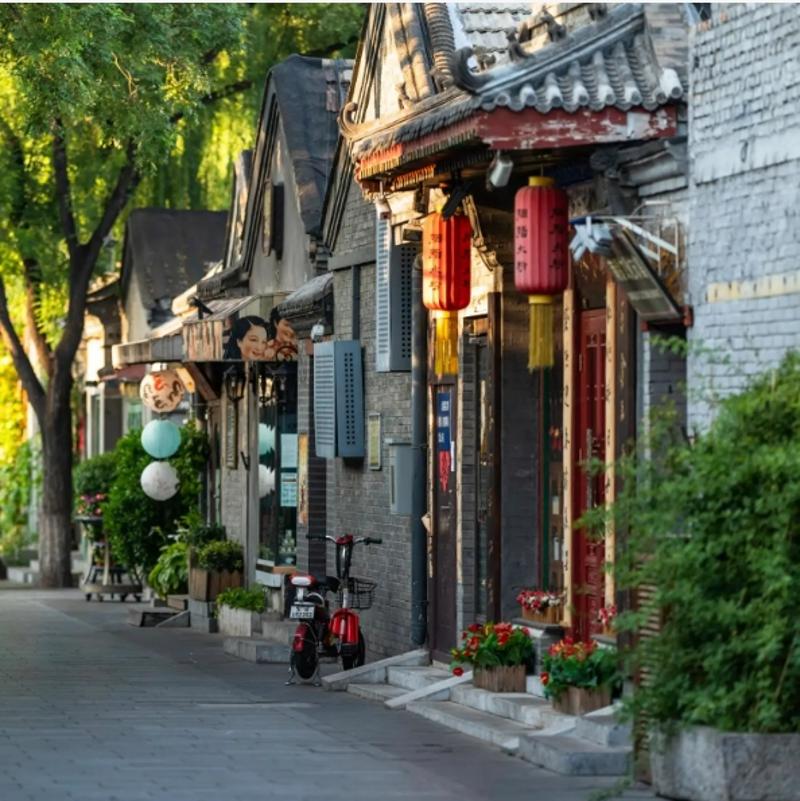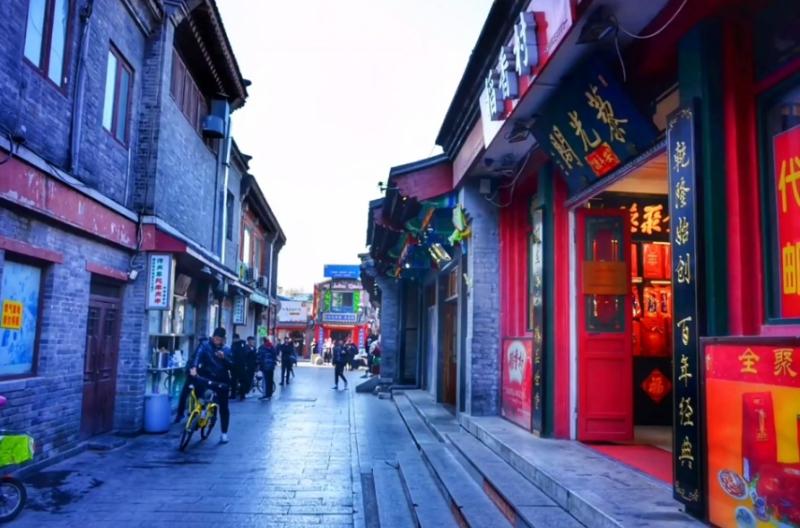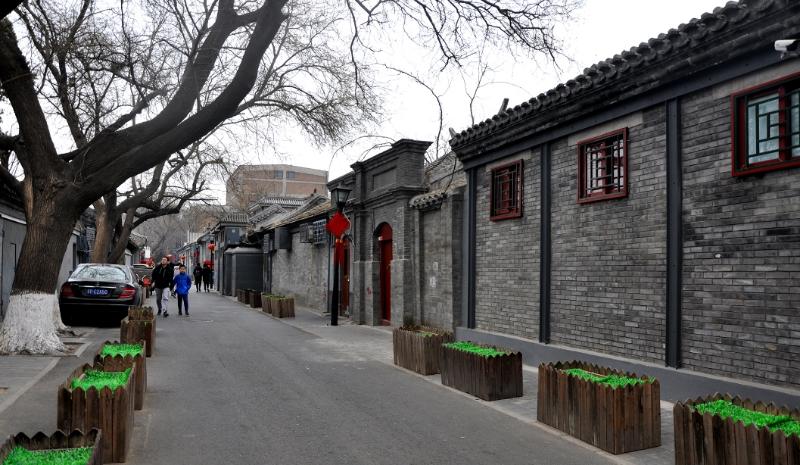Exploring Beijing Shichahai Hutongs
The term "hutong" originated from the Mongolian word "hottog," meaning "well." Villagers dug a well and settled around it. Hutong refers to alleys or lanes formed by the lines of traditional courtyard houses where old Beijing residents lived.
Many of these areas are now protected to preserve their unique architecture. Nanluoguxiang is one of them, proving to be a fusion of history, fashion, and shops. It's no wonder it's highly favored by tourists, especially the younger generation. Nanluoguxiang is also an ideal dining spot, with many different restaurants offering Western cuisine like pizza and coffee. Chinese cuisine is also available. Several shops in the area will sell many unique gifts, such as plates and coasters with artistic designs, catching your attention. Nanluoguxiang is an alley full of surprises and happiness. If you come to Beijing, be sure not to miss it.

Reference : Shichahai: History, Scenery, and Culture
Yandaixiejie - One of Beijing's Oldest Streets
Location: Xicheng District, Beijing
Nearby Attractions: Drum Tower, Houhai, Shichahai
Yandaixiejie, built during the Yuan Dynasty, is located on the north side of Anmenwai Street in front of Shichahai in Beijing. It was named one of the "Historical and Cultural Blocks of China" by the Ministry of Culture and the National Cultural Heritage Administration on November 10, 2010, following the Beijing Guozijian. This street is about 232 meters long and 5-6 meters wide, resembling a smoking pipe, hence its name, and is one of Beijing's oldest commercial streets, with numerous hotels, inns, and other foreign trade shops. The architectural style here is simple and elegant, with Beijing's northern characteristics. It is a famous cultural street in Beijing, leaving many cultural celebrities' footprints behind.

Ma'er Hutong - Homeland of Cultural Relics, Celebrities, and Stories
Location: Northwestern part of Dongcheng District, Beijing
Nearby Attractions: Nanluoguxiang, Mao Dun's Former Residence
Ma'er Hutong is one of the most famous hutongs among the only 25 protected hutongs in Beijing. With a total length of 585 meters and a width of 7 meters, it lacks the loneliness of ordinary old streets and lanes. It is connected to bustling streets at both ends, and cars shuttle through the lane from time to time. In the dense streets, fashionable cars and old-fashioned tricycles shuttle between the red gates and gray walls, faintly revealing the prominent status of Ma'er Hutong. Although Ma'er Hutong, with a history of over a hundred years, has experienced the ravages of time, it still retains its original features. There is often an ancient tree in the courtyard, such as a jujube tree, cypress, or locust tree. On hot summer days, the elderly sit in the shade, fanning themselves and chatting, while children play at the door. Such scenes are so happy and leisurely.

Guozijian Street - Beijing's Famous "Scholarly" Hutong
Location: Northwestern part of Dongcheng District, Beijing
Nearby Attractions: Yonghe Temple, Guozijian, Temple of Confucius
Guozijian Street, also known for being associated with Confucius, is a hutong running east-west. With a history of over 700 years, it still maintains the old Beijing hutong style. It is one of the first "Historical and Cultural Blocks of China" and the only city-level protected street named after a street name. This ancient street concentrates a large number of historical and cultural heritages of national-level cultural relics such as Guozijian and Confucian Temple. It is also the only remaining archway street in Beijing, condensing the essence of traditional Chinese culture. With its elegant, quiet, solemn, and mysterious environment and rich historical and cultural connotations, it has become a unique cultural area in Beijing.
Other Famous Hutongs in Beijing
Liulichang: Located in Xicheng District, Beijing, 1 kilometer from Tiananmen Square, it is the most cultural hutong in Beijing; it is also one of China's largest antique markets and an ideal place to visit for traditional "study four treasures" (writing brush, ink stick, paper, and inkstone).
Jinyu Hutong: Also known as Jinyu Hutong, it is located next to Wangfujing Commercial Street and is the most modern hutong in Beijing, with many large-brand hotels and shopping centers.
Dongjiaominxiang: Located in Dongcheng District, Beijing, adjacent to Tiananmen Square, it is the longest hutong in Beijing, about 3 kilometers long.
Xijiaominxiang: Located in the southern part of Xicheng District, it was Beijing's original Financial Street, chosen by domestic and foreign banks for their operations.
Juer Hutong: Located in the northwestern part of Dongcheng District, west of Nanluoguxiang, it is a hutong that shows you the changes in Beijing's history.
The best way to explore the hutongs is by rickshaw. You'll find many rickshaws waiting for tourists in the hutongs. You can bargain with them to take you on a tour. For more hutong tips, see the Beijing Hutong Travel Guide.
Origin of Beijing Hutong Names
Each hutong naturally acquired its own name. Once this name was accepted by the majority of locals, it truly represented the direction of the entire city's hutongs. Hutong names have become an indispensable symbol for people to connect and communicate, especially in today's tourism activities. The practicality of hutong names reflects the formation and development of hutongs. These names leave historical traces and reflect social customs. Beijing's hutongs are named after government offices, temples, altars, warehouses, workshops, bridges, rivers, markets, commodities, surnames, etc.
Image-Based Naming
Many hutongs are named after obvious images or symbols, reflecting the straightforwardness and humor of Beijing residents. For example, if a hutong looks wide, it is called "Wide Hutong" (Kuan Jie), indicating its width. If the hutong is narrow, it is called "Narrow Hutong" (Jian Hutong), indicating its narrowness. Rectangular hutongs are called "Box Hutong" (Hezi). Long and narrow hutongs are called "Bamboo Hutong" (Zhu Zi). There are many other examples.
Location-Based Naming
In the early days, prominent and obvious symbols were gates, temples, archways, fences, wells, rivers, bridges, and factories. Hutongs in these areas were named after their locations, such as Xizhimen Hutong, Waidajie Hutong, Qianyuan Ensi Hutong, Dongsi Hutong, Xidan Hutong, Crystal Hutong, Sanlihe Hutong, etc.
Naming Based on Trees and Plants
For some smaller hutongs nearby without obvious landmarks, but with many trees and plants, they are named after trees and plants, such as "Willow Tree Hutong" (Liu Shu Hutong), "Jujube Tree Hutong" (Zao Shu Hutong), "Fragrant Spring Hutong" (Xiang Chun Hutong), etc.
Direction-Based Naming
Many hutongs in Beijing are named to provide good orientation for people. Therefore, many hutong names contain words like "East" (Dong), "West" (Xi), "South" (Nan), "North" (Bei), etc., such as Xihongmen Hutong, Nanyueya Hutong, Beibanbishan Hutong, etc.
Naming Based on Beijing Dialect
Since hutongs are named by residents living nearby, many names contain elements of the Beijing dialect, such as Beier'er Hutong, Qudeng'er Hutong, Yingzi Hutong, Gagā Hutong, etc.
Naming Based on Auspicious Words
Some hutong names convey good wishes. People often use auspicious words to name hutongs, such as "Happiness" (Xi), "Fortune" (Fu), "Longevity" (Shou), etc. Hutong names like Fusheng Hutong, Changshou Hutong, Ping'an Hutong, etc., are all named after auspicious words.
Naming Based on Temples
Some hutongs are named after temples, such as Longfu Temple Street, Big Buddha Temple Street, Po Temple Street, Huguo Temple Street, and Zhengjue Temple Hutong.
Question 1: What is the origin of the term "hutong," and how does it relate to Beijing's historical development?
Answer 1:The term "hutong" originated from the Mongolian word "hottog," meaning "well." Villagers initially dug wells and settled around them. Over time, hutongs evolved into alleys or lanes formed by traditional courtyard houses, where old Beijing residents lived. During the Yuan Dynasty, specific measurements differentiated roads: those 36 meters wide were main streets, 18-meter-wide ones were minor streets, and 9-meter-wide alleys were hutongs. Despite this classification, Beijing's hutongs vary widely in width, ranging from 40 centimeters to 10 meters. These alleyways, with their myriad orientations and structures, often resemble mazes, contributing to their unique charm. Hutong names often reflect their origin, location, or historical significance, making them essential elements of Beijing's cultural heritage.
Question 2: How are Beijing's hutongs named, and what significance do these names hold?
Answer 2:Beijing's hutongs are named based on various factors such as imagery, location, trees and plants, orientation, Beijing dialect, auspicious characters, and temples. The names often reflect the physical characteristics, historical background, or cultural significance of the area. For example, hutongs may be named after notable landmarks, natural features, or even famous residents. These names serve as vital markers, allowing locals and visitors to navigate the intricate network of hutongs while also preserving the area's rich history and traditions.
Question 3: What are some famous hutongs in Beijing, and why are they significant?
Answer 3:Several famous hutongs in Beijing hold historical, cultural, and architectural significance. Nanluoguxiang, for instance, is renowned for its well-preserved Yuan Dynasty layout and vibrant mix of shops, restaurants, and cultural attractions. Yandaixiejie, resembling a smoking pipe, is one of Beijing's oldest commercial streets and a designated historical and cultural block. Ma'er Hutong, protected as one of Beijing's heritage sites, offers a glimpse into traditional courtyard life amid modern urban surroundings. Guozijian Street, steeped in Confucian heritage, is home to ancient relics and serves as a testament to Beijing's scholarly tradition. Other notable hutongs like Liulichang, Jinyu Hutong, Dongjiaominxiang, and Xijiaominxiang each contribute to Beijing's diverse cultural landscape, making them must-visit destinations for tourists seeking to explore the city's rich history and heritage.